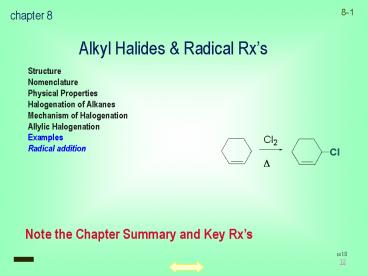Alkyl Halides PowerPoint PPT Presentation
1 / 27
Title: Alkyl Halides
1
chapter 8
Alkyl Halides Radical Rxs
Structure Nomenclature Physical
Properties Halogenation of Alkanes Mechanism of
Halogenation Allylic Halogenation Examples Radical
addition
Note the Chapter Summary and Key Rxs
ss18 12
2
free radical substitution mechanism
allylic benzylic Hammond radical addition
3
classification nomenclature
mechanism and details Hammond postulate
free radical substitution
4
8.1 Structure of R-X
haloalkane
R-X H3C-Cl
haloarene
sp3 (alkyl halide)
sp2 (aryl halide)
5
8.1 Structure of R-X
6
8.2 Nomenclature
IUPAC - halides (X) are substituents Substituent
names halo fluoro, chloro, bromo, iodo
-haloalkane
-halocycloalkane
(R)-4-bromo-1-chloro-4-fluoro-1-cyclopentene stru
cture ?
7
Common Names (alkyl halide) or (special names)
(isopropyl bromide) vs 2-bromopropane
8
8.3 Physical Properties
polar covalent bond - dipole - mismatch of
electronegativity -size
C
H
9
8.4 Halogenation of Alkanes
substitution of X for H
hv ultraviolet light, ? heat
X2 Cl2, Br2 seldom F2 (too reactive -
exothermic) or I2 (endothermic, unreactive)
10
Substitution, products and by-products
other R-Xs
11
Generally halogenation not useful -
mixtures (separate)
A few rxs are useful, e.g.
Others - allylic benzylic
12
Substitution, products and by-products
monobromination
13
initiation
propagation
terminations
14
Regioselective for 3o gt 2o gt 1o C-H
(92) (8)
(57) (43)
15
radical stability like carbocations -
R. is electron deficient (not charged)
16
Order of stability of R() / R.
17
free radical substitution mechanism
Hammond allylic benzylic radical addition
18
Selectivity 3o gt 2o gt 1o, but Cl and Br are
different
major mono-X product
Cl. more reactive less selective than Br.
19
Hammonds Postulate Cl vs Br
- Hammonds Postulate the structure of the
transition state - for an exothermic reaction looks more like the
reactants of that step
- for an endothermic reaction looks more like the
products of that step
20
Hammonds Postulate
- In halogenation of an alkane, the rate-limiting
step is hydrogen abstraction - this step is endothermic for bromination
- and exothermic for chlorination.
21
Hammonds Postulate
For chlorination (hydrogen abstraction is
exothermic)
- transition state resembles the alkane and
chlorine atom - little radical character on carbon in t.s.
- regioselectivity only slightly influenced by
radical stability
22
Hammond
23
Halogenation (free radical substitution)
24
Allyl Radical - resonance
25
(No Transcript)
26
NBS for Br2
27
Free Radical Stability
28
Free Radical Stability
29
(No Transcript)
30
(No Transcript)
31
(No Transcript)
32
(No Transcript)
33
(No Transcript)
34
Radical ADDITION - note rx conditions!!!
Add H-X in the presence of peroxides
reverses normal addition anti-Markovnikov
35
Radical ADDITION - note rx conditions!!!
Add H-X in the presence of peroxides
reverses normal addition anti-Markovnikov X
Cl, Br, I
end

